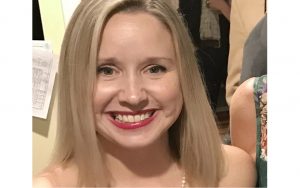The coronavirus pandemic has engendered fear, uncertainty and anxieties in virtually all segments of American society. But for individuals struggling with obsessive-compulsive disorder, particularly those whose obsessions revolve around germs and contamination, the emotional distress can be merciless and relentless.
Amy Nicholson, a Towson-based therapist and licensed clinical professional counselor, says she has seen a sharp spike in clients seeking mental health support since the start of the pandemic. Jmore recently spoke with Nicholson about OCD, how to recognize its symptoms, and how its sufferers can find relief.
Jmore: How do you define obsessive-compulsive disorder?
Nicholson: OCD is an anxiety disorder. Its hallmark is worrisome and intrusive thoughts that pop up and cause anxiety.

The compulsion [in OCD] is what people do to try to decrease the anxiety from their obsessive thoughts. For example, say someone thinks that every time their mother goes to the grocery store, she is going to have a car accident. That thought is so scary that the brain might give the person the idea that if I tap five times and then turn around, then nothing bad will happen. At first, performing this compulsion may lessen the anxiety. But the nature of the beast is that the more frequently the compulsion is performed, the less it will help with the anxiety.
In fact, after the first time the compulsion is performed, it never helps to the same degree as the first time. In that case, sometimes people will add on to the compulsion.
How is OCD treated?
OCD is best treated with cognitive and behavioral therapy and exposure and response therapy. That means there is a gradual desensitizing to the feared stimulus. First, the person acknowledges the intrusive thought and the resulting anxiety. Then, he resists performing the compulsion [in reaction to the intrusive thought].
[Prior to the pandemic] fears of contamination were dealt with by slowly working on exposure to the objects that the patient believes are contaminated. So if it’s a fear of contamination from touching a doorknob, we might start exposure therapy by having the patient get as close as possible to the doorknob without touching it. Then, we might have the patient touch the doorknob and wait 10 minutes without performing the compulsion.
Typically, if we wait at least 10 minutes, the anxiety goes down enough so the person doesn’t have to perform the compulsion.
What are you seeing with patients since the coronavirus hit?
I was actually surprised initially. I thought, ‘I’m going to see a lot of people worried about contracting the virus, but I ended up seeing two themes. On the one hand, in people with contamination OCD, the fear of contracting the virus is heightened. I have to come up with new ways for them to do exposure therapy that are safe. For example, I have a client who has contamination OCD and lives with his parents. Before the coronavirus broke, we were working on having him touch the kitchen sink that he shares with his parents and then touching his face. I’ve had to [change our therapy and] do more response prevention. Now, let’s say he goes into the kitchen and washes his hands. The therapy is for him to wash once, following the [Centers for Disease Control] guidelines for hand-washing, instead of washing multiple times. He might think, ‘Maybe I didn’t wash well enough,’ or ‘Maybe I missed a spot.’ Our goal is for him to deal with his anxiety without washing again.
The other theme I’ve noticed is that having too much time on your hands really exacerbates the disorder. So people’s obsessions are now saying to them, ‘Oh, you don’t have anything to do? I’ll just hang out with you all day.’ Worries that were once in the background are now in the forefront. That has nothing to do with the virus but more to do with our new routines. So some clients are coming back to therapy.
What’s it like transitioning to Zoom therapy?
It’s been a relatively easy transition. A few people don’t like it, and one patient is holding off until the pandemic is over.
There are some really great things about Zoom. I’ve been able to do in-home exposures. Last night, I Zoomed with a 12-year-old who has two bed-time rituals. One is around locking doors and one is a ritual she does in her bed, saying a little prayer and rolling on one side and then the other. We met from 8:30 to 9:30 p.m., so she walked me through the house and showed me, ‘Here’s the door. I think I can resist [checking that it is locked].’ I watched her resist. Then, I challenged her and said, ‘Let’s see if at the next door you can check with just your eyes and not your hands. Then, instead of checking with both eyes, close one of them.” People feel really good about showing their work. She was really proud.
If someone is experiencing OCD, what can they do?
If you’ve already been diagnosed with OCD and have been in therapy in the past, I would advise you to reach out to your therapist for what I call a ‘booster session.’ If not, a great way to find an OCD therapist is to go on the International OCD Foundation website, where they list therapists with expertise in OCD.
If people aren’t sure they’re ready for therapy, I suggest they track their obsessions and compulsions. Often, people with OCD symptoms feel really out of control. One way to feel more in control is to write down the thoughts that are popping in and the compulsions they are doing to deal with the anxiety. You can rate your anxiety on a scale from 1-10. Often, after doing that, people feel more in control and then they can decide whether to contact a therapist.
For information about obsessive compulsive disorder visit iocdf.org.





